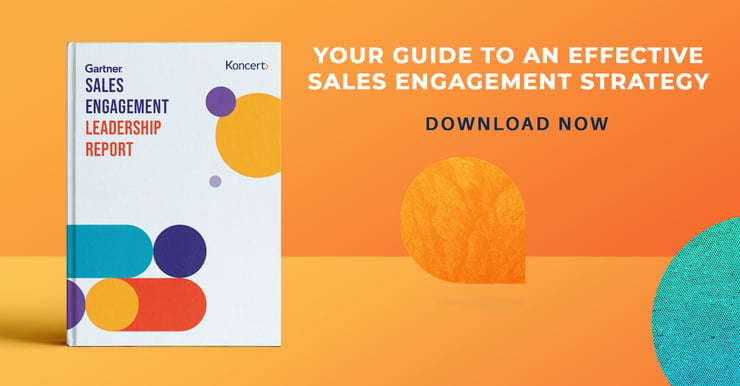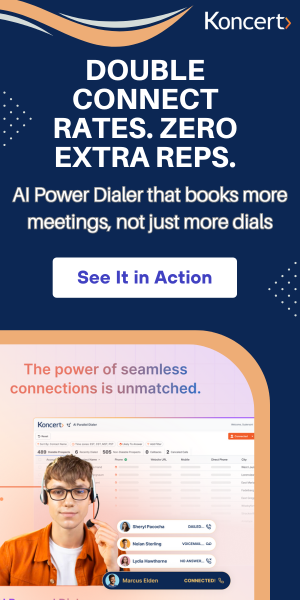
What a sales dialer might sound like an easy enough question at first glance. It’s a piece of technology or device you use to place sales calls, right? Yes, that’s the definition of a sales dialer, but there’s more that goes into it than that. Before you choose a sales dialing vendor, read on to learn about the different types of sales dialers and why those distinctions are so important.
Types of Sales Dialers
There are three main types of sales dialers:
Let’s go into each one to see what they mean, and how they’ll impact your B2B sales performance and productivity.
Learn the top terms in B2B sales. Read this blog.
What is a Click-to-Call Dialer?
A click-to-call (sometimes seen without the hyphens as "click to call") dialer stems from technology anyone who has used the web is familiar with. For example, if you want to find out the hours of a retail store and they don’t have it on their site, what do you do? Your search for the store, find the phone number, and then click on the number listed there to call it from your smartphone.
In the B2B sales world, click-to-call dialing, which we call Click Dialer, works the same way. You choose the potential customer that you want to reach in your Salesforce or other CRM system, click on their number, and call it from your laptop. By clicking on the number to call it, you don’t have to worry about entering the numbers wrong when you dial.
With Click Dialer, call results, emails sent, voicemails left, and follow-up activities are all updated in Salesforce in real-time. Sales reps using Click Dialer can increase their calling productivity by up to 30% over manual dialing.
What is a List-Based Dialer?
With a list-based dialer, like our Workflow Dialer, you upload a list of B2B sales prospects into your CRM system. Once you’ve started calling, you click on the first number to initiate that call, and then work your way through your list one by one, checking off anyone that you don't want to dial on your list. Think of it as the next step up to click-to-call dialing.
Flow Dialer provides visibility into calls, allowing your B2B sales reps to control the selection of the next call and progress to that call quickly. Sales reps using our personal Flow Dialer can increase their calling productivity by 50% to 100% over manual dialing.
What is Agent-Assisted Dialing?
With agent-assisted dialing, either robot or human agents make the dials to take the busywork of navigating through gatekeepers, voicemail systems, busy signals, and wrong numbers away from the sales rep. This leaves your sales reps to focus on actually having sales conversations. Once the sales rep indicates that they’re ready for the next conversation, the agent or agents start dialing until they reach a live person, at which point the call is transferred to the sales rep. During that call, the agents stop dialing until the call is over and they’re told by your sales rep to start dialing back up.
The distinction between robot and human agents is an important one. Telephone Consumer Protection Act (TCPA) compliance regulations note that each call has to be initiated and followed through on until the end of the call by an actual human. The use of robot agents is what is referred to as “Power Dialing,” “Predictive Dialing,” or “Robo Dialing.” In order to be compliant, you don’t want any of those.
Instead, we’ve introduced the term “human power dialing” with Agent-Assisted Dialer, which is our human agent-assisted dialing solution. Sales reps that use Agent-Assisted Dialer can consistently make typically over 125 dials and have between 7-10 live conversations in one hour, on average. Most sales reps need a full day to make over 125 calls, but now, your sales reps can make that number of calls in just one hour. Think about the 800% increase in productivity you’ll have when your sales reps are able to reach more people and have more conversations each 8-hour day.
5 Tips to Improve Your Sales Dialing
- Learn how to best engage with each of your potential customers by trying all the ways of a multi-channel sales outreach: cold calls through your choice of sales dialer, cold emails, LinkedIn, and embedded video in email.
- Use a sales dialer that’s integrated into Salesforce or another CRM. That way, you’ll have all of the information you need in a single pane of glass and won’t have to click around various windows to find the data. Also, your actions with the sales dialer will all be noted right in Salesforce for you.
- This seems simple, but it’s not. Be human in your sales conversations. Don’t come off as a robot or like you’re saying or send the same thing to every contact
- Along with being human, show high energy and know what to say in the first 10 minutes of your cold call to turn that first call into the next call of a warmer conversation that will lead to a sale.
- Use sales engagement technology that will help you make more dials, have more conversations, send more emails, and do so in a smart manner.
Use the Right Technology
The right sales engagement technology can save your B2B sales team time, increase productivity, and ease their stress. Sales engagement technology also removes the gruntwork of navigating through phone trees and getting past gatekeepers, so your sales reps can focus on what they do best — having sales conversations that lead to meetings and sales.
Cold calls that are followed up with emails and vice versa are another part of sales engagement technology that can’t be overlooked. To create a consistent experience across your prospects, sales reps should utilize sales cadence software like Cadence and sales dialers like Click Dialer, our personal Flow Dialer, and Agent-Assisted Dialer to send emails and create call tasks at the right time in the buyer’s journey.
Reach out to us here at Koncert today to learn more about our entire suite of sales engagement software, including the Agent-Assisted Dialer, and our human power dialer. Simply click here or give us a call at 800-955-5040.
Related Posts
10 min read
High-Quality Outreach - Why Koncert's ZigZag Dialing® Replaces Call Blasting
Dec 12, 2025 by Koncert Marketing
13 min read
7 Outbound Sales Trends for 2026 - AI, Latency, & Max Connect
Dec 4, 2025 by Koncert Marketing



